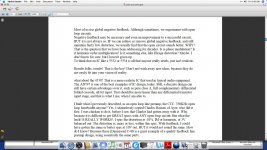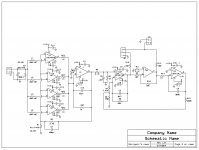Nice to see they are plugging in the Parasound DAC one of my favorite opamps, the LME49990.
For low source resistance noise, it's just pipped by the AD797, while distortion for both is well below 1 ppm.
With an equivalent reflected input source resistance of c. 800 ohms, I'm calculating -110 dBV
AD in the digital path I see 😉. I've been playing with the new AD1955 reference design in differential mode, fairly impressive. Measurements of course, it passes a multitone better than an old Crystal design. Yes I'm biased, but don't hide it. 😀
Last edited:
Oh look it's fanboy city in here now 🙄
Well if all you require is a one sided opinion and not a lot of truth then yes, a book written by JC might be your cup of tea. 😉
So placing a cap and gas discharge device on the Bybee box is JC's claim to fame so he placed his name on the outside? Okaaaaaaaaaaaay 🙄 That infers that he also believes and endorses all the claims for it.
Where's the moderator anyway? This is just too much.
Where's the moderator anyway? This is just too much.
You should ask his claim to fame ............😀
You should ask his claim to fame ............😀
It's pretty obvious there isn't one. Why bother?
Oh look it's fanboy city in here now 🙄
Well if all you require is a one sided opinion and not a lot of truth then yes, a book written by JC might be your cup of tea. 😉
So placing a cap and gas discharge device on the Bybee box is JC's claim to fame so he placed his name on the outside? Okaaaaaaaaaaaay 🙄 That infers that he also believes and endorses all the claims for it.
I think you got it upside down.
So far, I have been able to read books by Douglas Self, Bob Cordell and Ben Duncan. I have had an opportunity to read all sorts of comments by fans prclaiming the to the Word of God, no less, and all others to be False Prophets.
Therefore, we need a book, however subjective, from John Curl to be able to read ANY other view other than the "hit it wit 80+ of global NFB and it will be all right".
Personally, I find that approach a good way to create mostly bland audio products, although I readily admit that this approach has produced a number of very good sounding amps as well. That said, on a statistical basis, I have heard an incomparably larger percentage of low global NFB amps, although just having a low global NFB does not mean it will automatically sound better.
I differ from John on one point only, that I have come across so far, and that is making use of no global NFB at all. I admit to having heard very few amplifiers using this approach, but no matter how different they sounded among themselves, all left me with a distinct feeling of not quite having said it all, somehow unfinished, a bit loose, if you like.
My conclusion was that SOME global NFB could be beficial to the overall sound. How much is "some" is, I believe, impossible to generalize into plain numbers, as this will depend on many individual amp characteristics, so let me put it this way - Harman/Kardon was quite happy to use 12 dB, just 3:1, global NFB on a number of their amps, from HK 680 integrated to their "de luxe" Citation series 22 and 24. I own both, so I am speaking from first hand experience, not hear-say. And Harman/Kardon is no High End company, even their Citation series barely approaches the High End lower limit.
My own dabbling in power amps shows that if you need more than 20 dB of global NFB, something is probably not quite all right with the amp, or you are a specs fan.
Having heard Cambridge audio amps dating back the last 5 or so years, which are associated with Mr Self, I know for a fact I'd never buy them. No obvious flaws, to be sure, but no life, no fire, no brimstone either. I don't know how much of Mr Self's input is built into them, but that doesn't really matter, once he had allowed his name to be associated with them. In the words of HM Queen Victoria, when the little dog peed onto the throne: we are not amused.
Unfortunately, I have not heard Mr Cordell's work, and of JC's work, I have experience with only one model, which was with me for about 12 days, the HCA 1205 (a bit old now). That was quite enough to tell me who's who, unfortunately that unit was snatched away from right under my nose.
Ultimately, if you object to JC's input, then don't read it.
Scott,
So I would think that with a combination of IC's and discrete components use together that you could have all the current carrying ability you would want. Us the IC's where current is not the issue and discrete components where you need to generate the current such as output devices in the amplification stage. I have seen many designs that seem to marry the two types of devices where each has its strong points.
So I would think that with a combination of IC's and discrete components use together that you could have all the current carrying ability you would want. Us the IC's where current is not the issue and discrete components where you need to generate the current such as output devices in the amplification stage. I have seen many designs that seem to marry the two types of devices where each has its strong points.
Where's the moderator anyway? This is just too much.
Strong technical disagreement is absolutely OK. Only personal insult matters. Please try to distinguish between the two 😀. Some are unable and take technical disagreement as a personal insult 😉
I offered to post my redo of a JC IC based design. So here it is.
R9 = R10 = 10k = too much. No, thanks 😀
Replace U2 with something able to drive 1k and go down with impedances. 2134 is obsolete and badly behaving into lower impedances. We've had some progress since 1995 😉
Last edited:
Strong technical disagreement is absolutely OK. Only personal insult matters. Please try to distinguish between the two 😀. Some are unable and take technical disagreement as a personal insult 😉
It was a personal insult and not only directed at JC ....🙄
John,
Thank you for posting that excerpt of the pdf. I will read through the entire paper when I get a chance. I have no real quarrel with you, personally or intellectually, that does not mean that I will agree with everything you say or do. I am just that way with anyone, I listen and observe and then make up my own mind what to take away from a conversation. Believe me I do that with others who design speakers, sometimes I will put up an argument and win and other times I will be shown where my argument falls down and I accept the other persons position. It is s journey and some of us truly are on a quest to learn all that we can. There are more than a few brilliant minds on this thread. Many people may not be employed in the audio field but have knowledge that is worth seeking out. I know some of these peoples backgrounds and occupations from LinkedIn and am more than amazed at some of the work being done by different people here.
Thank you for posting that excerpt of the pdf. I will read through the entire paper when I get a chance. I have no real quarrel with you, personally or intellectually, that does not mean that I will agree with everything you say or do. I am just that way with anyone, I listen and observe and then make up my own mind what to take away from a conversation. Believe me I do that with others who design speakers, sometimes I will put up an argument and win and other times I will be shown where my argument falls down and I accept the other persons position. It is s journey and some of us truly are on a quest to learn all that we can. There are more than a few brilliant minds on this thread. Many people may not be employed in the audio field but have knowledge that is worth seeking out. I know some of these peoples backgrounds and occupations from LinkedIn and am more than amazed at some of the work being done by different people here.
dvv,
Sometimes I find it better to be somewhat diplomatic in my use of words. Reasonable was one of those words. I don't want to disparage all the designers out there of low cost speakers, they do have to meet a specific price point for the designs they do. Even a few cents is a major factor if you are making millions of small devices.
Sometimes I find it better to be somewhat diplomatic in my use of words. Reasonable was one of those words. I don't want to disparage all the designers out there of low cost speakers, they do have to meet a specific price point for the designs they do. Even a few cents is a major factor if you are making millions of small devices.
A new link stage
Based on Scott Wurcer's idea, I have built a new link stage, several month ago. With the best SOTA AD IC's. Let me attach a basic schematics, some parts are missing and values are not declared.
It is the most transparent preamp I've ever heard.
Based on Scott Wurcer's idea, I have built a new link stage, several month ago. With the best SOTA AD IC's. Let me attach a basic schematics, some parts are missing and values are not declared.
It is the most transparent preamp I've ever heard.
Attachments
- Status
- Not open for further replies.
- Home
- Member Areas
- The Lounge
- John Curl's Blowtorch preamplifier part II




